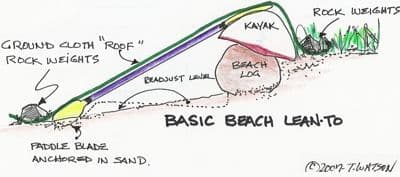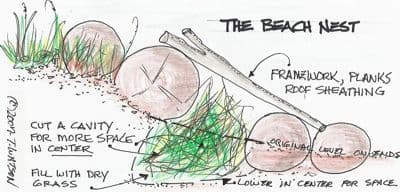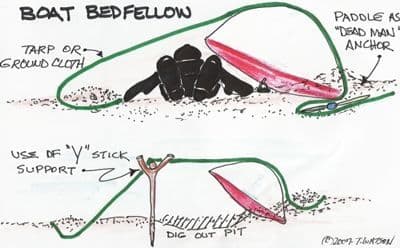Basic Beach Shelters
In Kurasawa’s classic film Dersu Usala, the two principle characters, Usala, the Mongolian guide and the Siberian surveyor he is leading through the uncharted reaches of central Siberia are caught totally unprepared by a winter blizzard in the middle of an expansive grassy plain. With nothing but their surveying gear, Usala is able to make a shelter using blades of dried grass, the transit’s tripod and a ground cloth. They survive sub-zero wind chills and endure the storm huddled in a fetal position like a couple of field mice.
As kayakers we’d not likely be exposed to quite the severe extent the surveying party did, but we may find ourselves in a situation where our means of survival include barely any more gear that what’s with us for a day’s paddle. Most kayaking environments offer enough natural resources that when combined with materials we as paddlers generally have at hand, to make an adequate overnight shelter. At a minimum such shelters can provide basic comfort, both physically and psychologically.

Before needing to resort to natural materials scavenged on the beach, a prudent kayaker would have an emergency kit already prepared and part of the inventory of gear brought along on every trip. Whenever I paddled in the north Pacific off of Kodiak, I had a pack that stayed in the nose of my boat all summer. It contained a change of under layer clothing (pants, shirt, and socks), an emergency supply of food and water, fire starting materials and a small one-person tube tent with a fist full of parachute cord. It was a self contained emergency spike camp in a stuff bag the size of a loaf of bread.
Oftentimes, however, when enjoying a relaxing getaway to a remote island beach, I’d often seek out natural shelters and practice preparing an emergency den in which I could lie. This practice kept skills I hoped I’d never need in an active mode and enabled me to come up with quite a few alternate emergency shelter scenarios.
Here are a few basic shelter options one can quickly make using just one’s kayak/canoe, a paddle and a ground cloth. In some instances you may have to get by without any one of those items, too.

The Boat Hull Lean-To Basically this involves using either a canoe or kayak hull as the top cross support for a shelter. This works especially well if the boat is placed laterally atop a log at the upper end of a sloping beach. Basically the canoe and log form a wall behind which you can position yourself against the wind, rain and/or sun. Using a paddle as a cross beam and your ground cloth as a roof covering, you can make a modified lean-to quickly and easily. Depending upon the size of the ground cloth, you can angle its coverage so the corners can drop down to form side protection as well.
There are two basic modifications of this particular method. The first is when you may not have a paddle, or have used it for another purpose. On most beaches there is enough debris to build more than adequate structures. Limbs of varying lengths and diameter as well as well-worn lumber and even siding can be found – all great materials for assembling a structure.
Instead of using your paddle, consider making a simple framework of branches, small tree trucks and stems or appropriate lengths of lumber. If you find line or a net you can cut into working lengths of line, you can lash together a suitable framework to place over your shelter. Then, either top it with your ground cloth or use grasses, pieces of plastic or other covering to make your roof. The lashing has to work; it doesn’t have to win you a merit badge. Several granny knots will hold a cross piece in place in an emergency situation.
The Beach Nest
The most basic structure is the grass nest. It works for animals, it’ll work for you. There are two essential tasks to complete to make an adequate shelter from grass. The first is obvious: an adequate supply of easily harvested dry grass. Sometimes this can be gathered by raking through a think growth and removing the dried thrash from the current year’s growth. In some places the dried grass uproots or breaks so easily that you can pick huge bouquets by the armload.

The second element is a protected place to deposit and build up a dome of grass to form a dense pile into which you can burrow yourself or can pull in around you to fill in a small depression. I found several logs strewn out along a beach with small, elongated cavities formed between them. Those along the edge of the beach, near the high water mark, were lined up in such a way that you could scoop out some of the sand underneath the center section of a log and fill that excavation with dried grass. This made for a very secure shelter that was even more protective when a roof was added across the top of several logs.
The Boat Bedfellow
I’ve never tried this approach, but in extreme situations where there are no other wind barriers or protective nooks, such as logs or sand berms, you could hunker down along side your overturned kayak and make the best of it. Your paddle could wedge the edge of the ground cloth on the backside of the boat hull and the other end could be wrapped around your backside. If you didn’t have a ground cloth, you might want to look for sections of plastic, netting, plywood, etc. to lie against the hull and crawl in between. A sandy beach will enable you to carve out a shallow depression for your hips and shoulder.

In all these scenarios, consider storing extra gear inside your kayak. It’s protected from the elements and adds a degree of ballast to the boat. Being resourceful gives you a few extra points on the survival scale. Whether you plan to take such Robinson Crusoe measures yourself or just plan ahead with an emergency kit of adequate inventory is up to you. It’s all one more way of being a prudent, safety-conscious kayaker.
Tom Watson, an avid sea kayaker and freelance writer is also the author of "How to Think Like A Survivor" available on Amazon.com and most major bookstores.
Related Articles
This a follow up to a video I did where I talked about differences that you may find in dry and semi-dry…
The most important knot for all paddlers to know is the Trucker’s Hitch knot. It is a simple knot that…
A kayaking buddy, we'll call him "Ben", is one heck of a paddler. He's got years of big, blue water…
Experienced wilderness canoe trippers know that small errors can cause big problems. In my previous…



